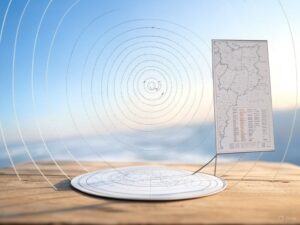Anticyclone: What It Is and How It Influences Weather and Climate
Meta Description
An anticyclone is a high-pressure system with winds that rotate clockwise (NH) or counterclockwise (SH). Discover how it affects the climate, from clear skies to heatwaves.
Introduction
Anticyclones are high-pressure atmospheric systems associated with stable weather, clear skies, and, in some cases, extreme conditions like heatwaves or droughts. They are essential for understanding weather patterns across all latitudes.
In this article, you’ll learn:
✔ What an anticyclone is and how it forms
✔ Why its winds rotate differently depending on the hemisphere
✔ How it influences the climate (from sunny skies to trapped pollution)
✔ Key differences between anticyclones and low-pressure systems (depressions)
What Is an Anticyclone?
An anticyclone is an area of high atmospheric pressure where air descends from the upper atmosphere, generating:
- Gentle winds that rotate clockwise (Northern Hemisphere) or counterclockwise (Southern Hemisphere).
- Stable weather: Few clouds and little precipitation.
- Temperature inversion: Cold air gets trapped near the surface, increasing pollution in cities.
Key Characteristics
1. Wind Circulation
- Northern Hemisphere: Clockwise rotation (air moves outward from the center).
- Southern Hemisphere: Counterclockwise rotation.
(This is due to the Coriolis effect, which deflects winds due to Earth’s rotation.)
2. Types of Anticyclones
- Thermal: Caused by air cooling (e.g., Siberian High in winter).
- Dynamic: Caused by air subsidence in subtropical latitudes (e.g., Azores High).
3. Atmospheric Pressure
- Typically has pressures above 1020 hPa (hectopascals).
Effects on Weather and Climate
1. Clear and Stable Weather
- Descending air inhibits cloud formation and rainfall.
- Results in blue, sunny skies.
2. Heatwaves
- Persistent anticyclones (e.g., “blocking highs”) can cause extreme temperatures and droughts.
3. Trapped Pollution
- Temperature inversion prevents pollutant dispersion (e.g., smog in Mexico City or Santiago).
4. Nighttime Frost
- In winter, clear skies promote heat loss and radiation frosts.
Famous Anticyclones
- Azores High – Key to Europe and the Canary Islands’ climate. Brings dry summers to the Mediterranean.
- Siberian High – Causes frigid winters in Asia with temperatures below -40°C.
- South Pacific High – Influences Chile and Peru’s climate (e.g., dry winters in Santiago).
Anticyclone vs. Depression: Key Differences
| Anticyclone (High Pressure) | Depression (Low Pressure) |
|---|---|
| Descending air | Ascending air |
| Gentle winds | Strong winds |
| Clear skies | Clouds and rain |
| Clockwise (NH) / counterclockwise (SH) | Counterclockwise (NH) / clockwise (SH) |
How Are Anticyclones Detected?
- Weather maps: Identified by an “H” or closed isobars with high values (e.g., 1030 hPa).
- Weather satellites: Show cloud-free zones linked to high pressure.
- Radiosondes: Measure vertical temperature and humidity profiles.
Impact on Climate Change
Subtropical anticyclones (like the Azores High) may intensify with global warming, increasing droughts in regions like the Mediterranean.
Key Takeaways
✅ A high-pressure system with rotating winds (clockwise NH / counterclockwise SH).
✅ Associated with stable weather, but also heatwaves and pollution.
✅ Crucial in subtropical climates (e.g., Azores High).
✅ Monitored via isobar maps, satellites, and climate models.
FAQ
Q: Why does an anticyclone cause clear skies?
A: Descending air warms up and prevents cloud formation.
Q: Can an anticyclone bring rain?
A: Not directly, but its edges can interact with moist fronts.
Q: How does it affect aviation?
A: Flights are smoother due to atmospheric stability, but temperature inversion may increase turbulence near the ground.

 Español
Español
 Nederlands
Nederlands
 Deutsch
Deutsch

